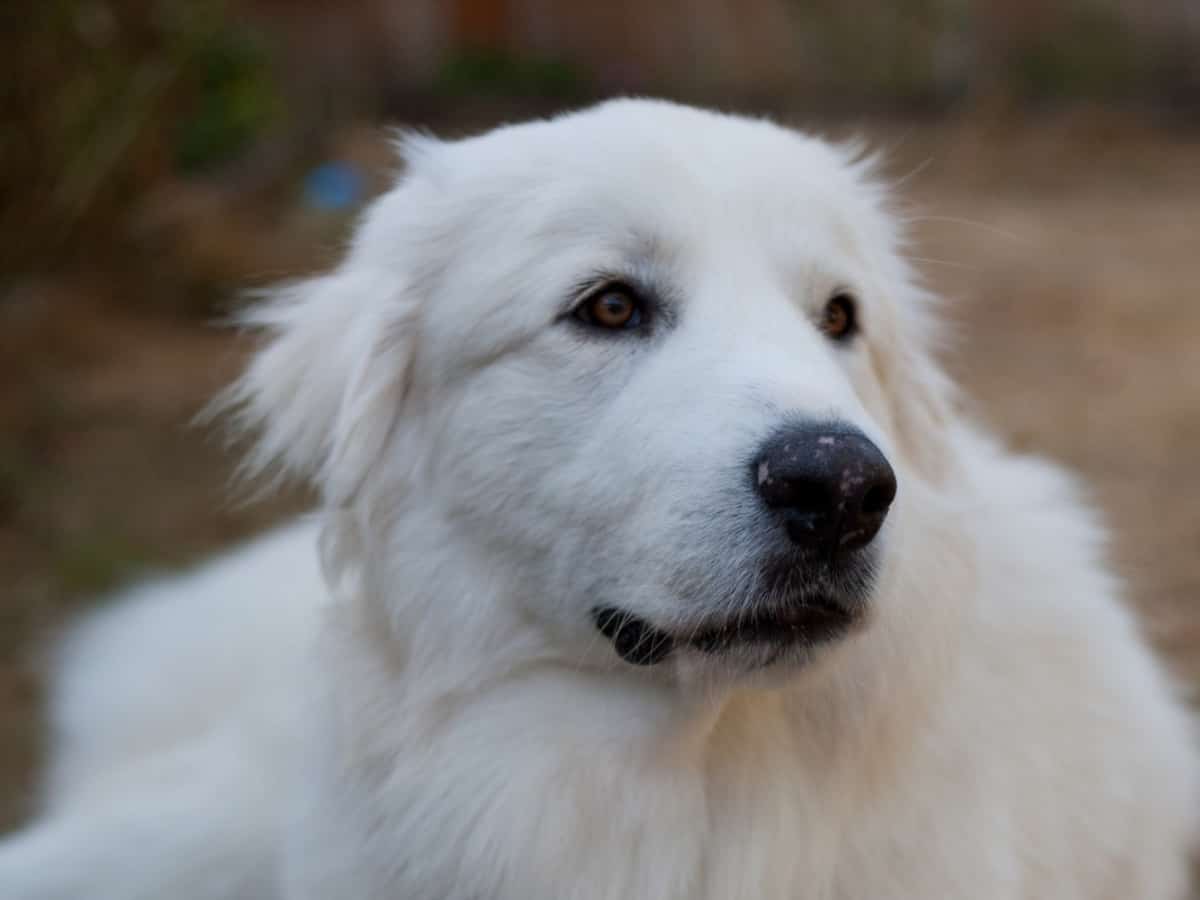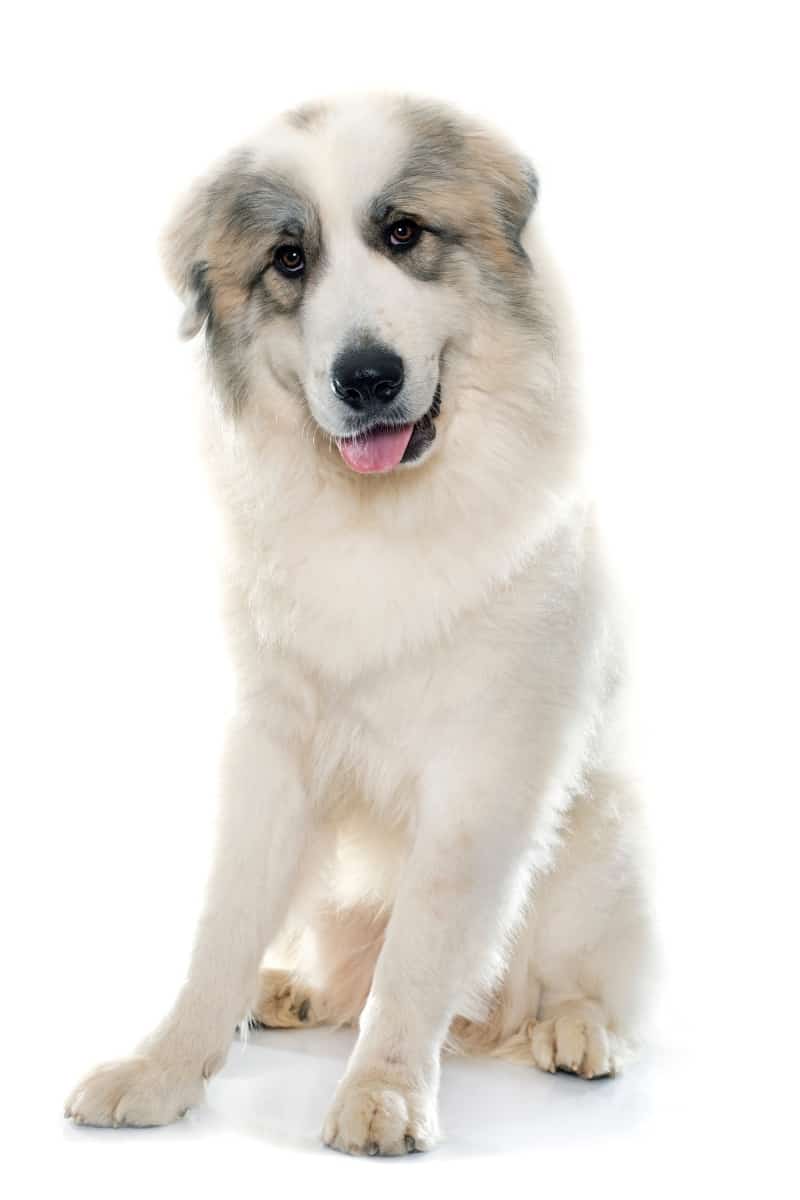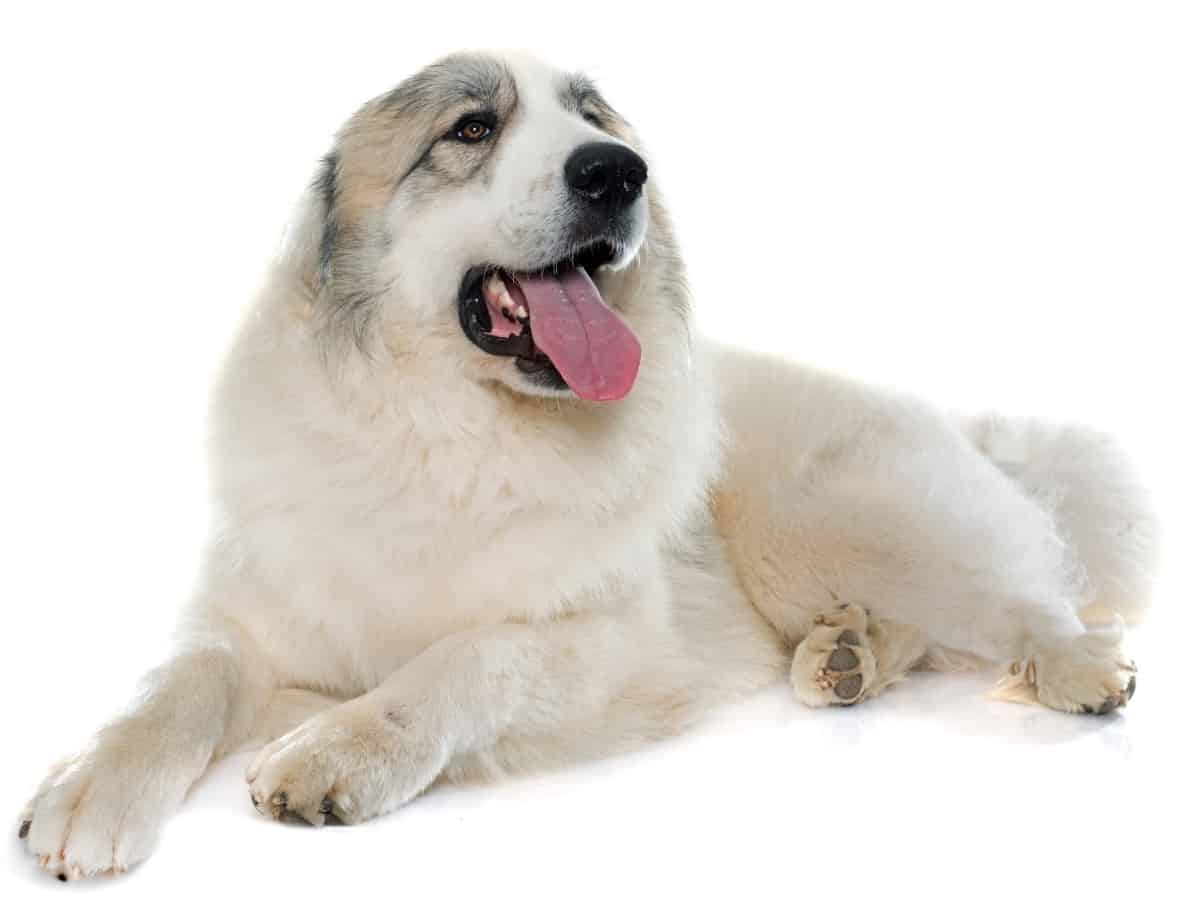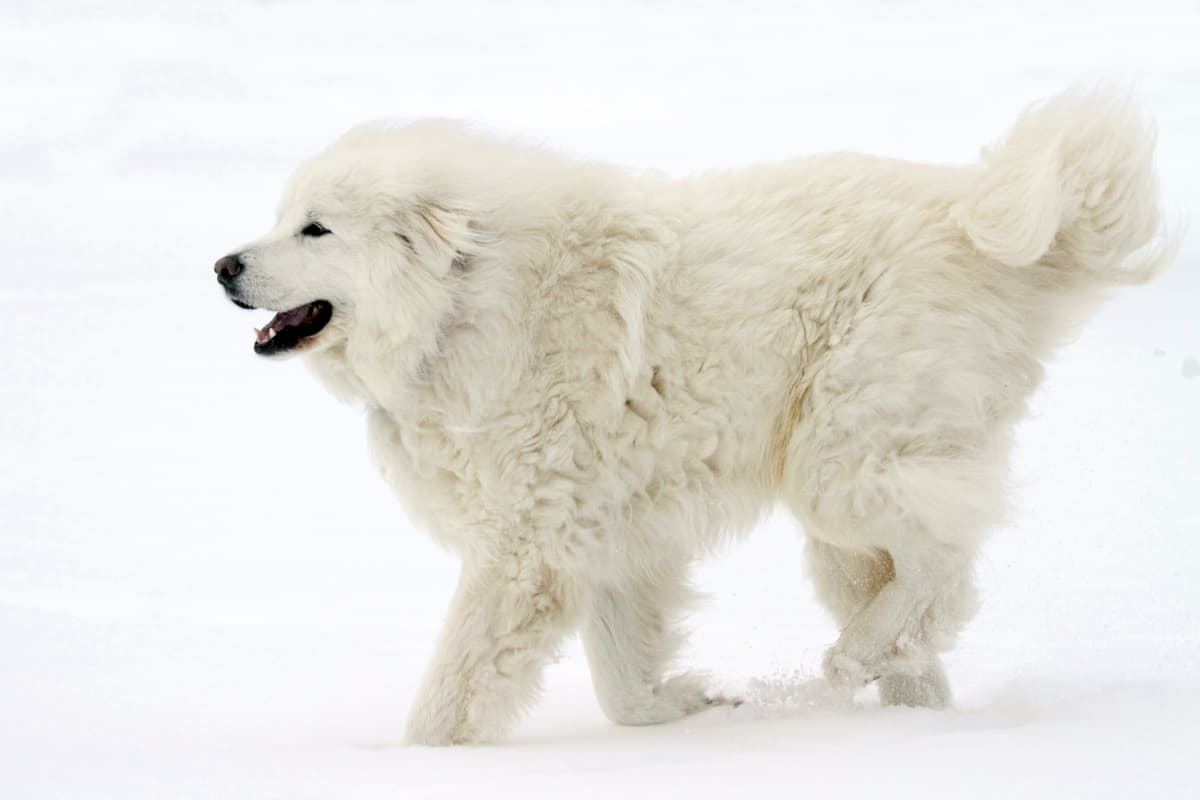If you’re a first-time owner of a female Great Pyrenees puppy, you might be concerned about your Great Pyrenees’ first heat cycle. Growing up, my family always had male dogs, so when I adopted my first female puppy, I wasn’t quite sure what to expect with her first estrous cycle.
The Great Pyrenees will enter puberty and begin their first heat cycle between 8 and 9 months old. It’s when ovulation takes place, and dogs will mate. After that time, most Great Pyrs will go into heat every 6 months. The heat or estrus phase typically lasts from 6 to 10 days.
You don’t have to worry when your Great Pyrenees begins her first heat cycle. In this article, I’ll explain what you need to know when your dog is in heat, how to help her, and which symptoms might be concerning.

What to Expect from Your Great Pyrenees’ First Heat Cycle
The Great Pyrenees is renowned for his unwavering loyalty to his family. A calm, well-behaved, and intelligent breed of dog, they are great protectors, having been bred to guard sheep, just like the mighty German Shepherd.
Great Pyrenees are a unique breed in that they have the appearance of a polar bear. Dogs are also unique in that they have one heat period every season. Wild animals’ heat cycles depend on climate and temperature, but your Great Pyrenees can go into normal heat cycles at any time of the year.
One thing to note is that most professional breeders don’t recommend breeding during the first heat cycle because your dog is still physically and mentally immature.
What Happens During the Estrous Cycle?
Two very similar words may confuse you when you research your dog’s first heat cycle. These are estrous and estrus. Although they sound the same, they have two different meanings.
- Estrous refers to the female’s four reproductive phases. These phases include proestrus, estrus, diestrus, and anestrus.
- Estrus refers to the heat period, which is the second phase of the estrous cycle.
You’ll notice specific symptoms and behaviors as your female Pyrenees goes through the following four phases of the estrous cycle.
Phase 1 – Proestrus
Before your dog goes into her first heat, she’ll enter the first estrous cycle phase. This is proestrus. This phase lasts from 2 to 27 days. The most common time is 7 to 10 days.
You’ll notice several physical changes in your dog during this time because of rising estrogen levels in your dog’s bloodstream. This causes all her reproductive tissues to become thick, her vulva swells, and her genitalia becomes red.
During this phase, don’t be alarmed when you see bloody discharge. Most likely, your dog will spend a lot of time licking her genitalia. The first time these symptoms occur, it can seem alarming, but it’s completely normal.
Other symptoms during proestrus include:
- Nervousness
- Loss of appetite
- Irritable with other animals
- Tries to escape confined space to look for a mate

Phase 2 – Estrus
This second phase of the estrous cycle is estrus. This phase is commonly known as the ”heat cycle” or ”standing heat.” Your Great Pyrenees can remain in this cycle from 2 to 21 days. Typically, it lasts from 6 to 10 days. This is the time when dogs mate with each other and ovulation takes place.
During estrus, the red bloody discharge turns a pink or beige color. This means your dog is nearing ovulation.
While your Great Pyrenees is in her first heat, she’ll demonstrate the following behaviors:
- Flirts with males by backing into them
- Flagging tail in male’s face
- Urinates often
- Acts seductive
- Mounts males
Ovulation occurs from one to three days after the first heat begins.
Your Great Pyr may also be more hostile to other females and exhibit extra interest in male dogs. Urine marking, excitement, and repeated genital licking are other signs that a dog is ready to mate.
Keep your dog on a leash when out for walks if you have an intact Great Pyrenees and don’t intend to breed her at this time because your pet will be aggressively looking for a sexual partner.
Phase 3 – Diestrus
If you’re familiar with the estrous phases, you might have heard this phase referred to as metestrus. It’s now known as diestrus. This third phase lasts about two months and progesterone increases in the bloodstream.
Diestrus begins when the female dog starts refusing males and continues until the end of pregnancy. If you don’t mate your dog, her appearance doesn’t change during diestrus.
Phase 4 – Anestrus
The final phase of the estrous cycle is anestrus. This phase lasts from 100 to 150 days. Your dog’s reproductive system quiets down during this time.
When your Great Pyrenees goes through anestrus, she won’t show any signs of ”heat.” Her external genitalia returns to the normal color and the swelling recedes. The vaginal discharge also stops.
You’ll also notice your dog’s temperament improves, and she won’t be interested in any male dogs. This is the time her reproductive organs rest and stabilize again.
At What Age Will My Great Pyrenees Enter Her Heat Cycle?
Female dogs start their estrous or heat cycles when they start puberty, and they continue throughout life. Having your female spayed ends all estrous cycles.
“I had my dog spayed after her first heat cycle, but you should consult your vet if you’re considering neutering your dog.”
World of Dogz
All dogs enter puberty at various times. Many toy breeds start puberty as early as five months old, while puberty in giant breeds can be as late as 30 months.
Typically, your Great Pyrenees will enter puberty and begin their first heat cycle between eight and nine months old. After that time, most Great Pyrs experience estrous cycles twice per year.

How Long Does a Great Pyrenees’ First Heat Last?
A Great Pyrenees’ first heat lasts between 2 to 21 days. Typically, it lasts from 6 to 10 days. This part of the cycle equates to the estrus stage of the heat cycle. Your Great Pyr is fertile right now, so mating with her could result in a pregnancy.
Note, however, that a female Great Pyrenees can become pregnant if she happens to mate before the estrus period. This is due to the fact that canine spermatozoa are mobile in the female genital tract and may live for up to 11 days.
How Often Do Great Pyrenees Go Into Heat?
Great Pyrenees go into heat twice a year, approximately every 6 months. This is typical of large dog breeds, as smaller dogs may go into heat 3-4 times a year, and the largest breeds only once a year.
How often your Great Pyrenees goes into heat may vary and is contingent upon the following factors:
- Age – Following the first season, subsequent heat cycles may be irregular but will become more consistent in time. Senior dogs will have fewer heat cycles.
- Pregnancy – Following whelping, the interestrus interval is prolonged.
- Seasons – It is not an impossibility for seasons to affect estrus frequency. This study of large breed dogs found fewer estrus incidences in summer and consequently fewer occurrences of fertility and conception.
Are There Any Conditions That Influence the Great Pyrenees Estrous Cycle?
The following conditions can influence when your dog begins her estrous cycle:
- Injuries
- Diseases
- Nutrition
- Health and fitness
- Parasites
- Obesity
All of these conditions can cause problems during the reproductive cycle.
FAQs on Great Pyrenees First Heat and Cycle
What should I do if my Great Pyrenees’ heat cycle doesn’t stop?
Sometimes, the estrus phase continues longer than it should. In some cases, the vaginal bleeding doesn’t stop, and the genitalia remains swollen.
If your dog’s heat cycle continues longer than four weeks, call your veterinarian. A follicular cyst or ovarian tumor can cause persistent estrus. Your vet can conduct hormonal testing and ultrasound imaging to determine the cause.
Your veterinarian might choose to end your dog’s estrus cycle with estrus suppression medication.
Can my dog’s first heat be silent?
Yes, your dog’s first heat cycle can be silent. This happens occasionally. A silent heat cycle happens when your dog experiences estrus with no outward signs.
Most dog owners don’t realize their dog is in heat when this occurs. If your Great Pyrenees hasn’t had her first estrous cycle by the time she’s one year old, she may have had a silent heat.
Also, if you didn’t notice a heat cycle, your female dog might have missed her heat cycle. This is known as a ”skipped heat.” If you think your dog has skipped a heat, contact your veterinarian for any underlying reproductive problems.

How can I help my Great Pyr calm down during her heat cycle?
When your Great Pyrenees goes into heat for the first time, her personality and behavior change. She becomes agitated and cranky and displays strange behavior you’ve never seen before.
The first thing you want to do is put her at ease, especially when she seems so stressed. Here are a few things to calm her down and make her more comfortable:
- Spend extra time with her. This can include cuddling, playing, and simply chilling together. Talk to her in a calm voice, and give her a gentle massage to distract her from her anxiety. Provide her with the extra love and support she needs.
- Walk her frequently. However, make sure you avoid intact male dogs that could increase her stress. Instead, try to stick to quieter, less crowded areas for your walks and make sure to keep a close eye on her at all times.
- Play with her favorite toys to keep her busy. Puzzle toys are great for distracting her and mentally tiring her. I recommend the Outward Hound Dog Brick Puzzle Toy from Amazon. It is designed to challenge your dog’s problem-solving skills and encourage them to think critically.
- Provide her with a calm, quiet, and safe space to rest. This can include setting up a designated space for her to rest and relax, such as a crate or a small room with a comfortable bed. It’s also important to ensure that this space is safe so that she can’t escape or get into any mischief while in season.
Are there any hygiene products available to use during my dog’s first heat cycle?
Yes, pet supply stores carry various hygiene products for dogs in heat. Dog diapers or pants help absorb your dog’s bloody discharge. If you prefer online shopping, check out Simple Solution Disposable Diapers from Amazon.
These products also provide additional protection in case your female dog comes in contact with an interested male.
Will my Great Pyrenees experience pain during her heat cycle?
No, she shouldn’t experience any pain. She may appear nervous and moody, but that’s a normal part of the estrus phase. If you think she’s in pain, contact your veterinarian to make sure your dog doesn’t have a uterine infection or other related problems.
What are ”split heats”?
False heats, also known as ”split heats” are confusing, especially if your dog is approaching her first heat. This abnormality in the heat cycle happens when your female dog shows signs of entering proestrus. Then, before entering the heat cycle, all the signs of estrus disappear.
When the heat cycle begins several weeks later, it’s known as ”split heat.” You might hear this called ”wolf heat” as well.
Many young female dogs experience irregular estrous cycles. They usually become normal after the first few times.
How can I tell if my female dog has developed a uterine infection after her heat cycle?
A uterine infection, also known as a pyometra, sometimes occurs because of all the hormonal ups and downs during the estrous cycle. If her uterine wall remains thick from her heat cycle, it can produce fluid that enhances bacteria growth. This infection usually appears in dogs 6 to 10 years old.
Pyometra is a medical emergency, so if you notice any of the following symptoms two to three months after your dog finishes her heat cycle, contact your veterinarian immediately:
- Fatigue
- Depression
- No appetite
- Fever
- Painful abdomen
- Thirst
- Frequent urination
Your veterinarian can determine if your dog has a uterine infection through blood work and ultrasound imaging.
Let’s Wrap This Up!
Your Great Pyrenees’ first heat can be a challenging time for both your dog and you. It’s important to be prepared and take necessary precautions to ensure the safety and health of your dog during this time. This includes keeping your dog confined to prevent unwanted breeding.
With proper care and attention, your Great Pyrenees can navigate their first heat smoothly and comfortably. As always, it’s important to consult with a vet for any specific questions or concerns about your dog’s heat cycle.
Related Posts You May Like:





